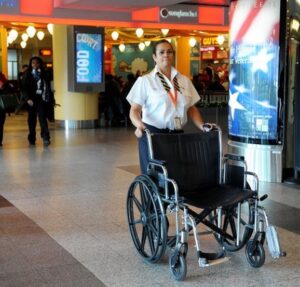 Now they make $8 an hour. The pandemic nearly quadrupled their pay.
Now they make $8 an hour. The pandemic nearly quadrupled their pay.
Airlines, to cut costs, contracted out baggage handling, cabin cleaning, security and janitorial services, and wheelchair assistance.
Third-party contractors performing these tasks typically pay their workers low wages with few or no benefits — much less than the airlines paid them. By cutting labor costs this way, the airlines increase their profits.
In the early 2000s, after Alaska Airlines laid off its baggage handlers and hired a contractor to do the work, gang graffiti was found in airplane cargo holds, and airport employees noticed that some of the baggage handling contractor’s employees were gang members (see story here).
You get what you pay for.
Now travel forward in time and cross-country to Dallas, where Larry Allen in 2019 made $2.13 an hour as a baggage handler. His employer got away with that because he was classified as a “tipped” employee. But travelers aren’t required to tip, so the $2.13 an hour was his only assured income. Then when the pandemic struck, he was laid off for a year, and upon being recalled he was offered a job as a wheelchair attendant at $8 an hour, plus whatever tips travelers see fit to bestow on him. Read his story here.
The Guardian says airport contractors are encountering “difficulties” filling these jobs. There’s much talk of a “Great Resignation.” If you look into it, you’ll find most job quitters aren’t leaving the workforce, they’re changing jobs. Simply put, they’re ditching bad jobs for better ones. Given an economy-wide labor shortage, they can. Call it Workers Revenge.
I have no sympathy for cheapskate employers. If they can’t pay decent wages, or refuse to, they shouldn’t be in business. The way I see it, if work has economic value of only $2 or $8 an hour, let it go undone. No one should work for such miserable pay. And now they don’t have to.
Economics is complicated, so let me try to simplify it. Economists and employers think of labor as an “input cost” just like materials, fuel, plant, and equipment. Let’s say you’re in construction and lumber is one of your input costs. Your lumber supplier can’t sell lumber below cost and stay in business. So why would you expect a carpenter to supply his labor for less than his cost of living? He can’t.
One way workers get a living wage is by joining unions. Many states passed anti-union legislation called “right-to-work” laws to keep wages low. The federal minimum wage is stuck at $7.25 an hour ($2.13 for “tipped” employees) because Republicans block efforts to raise it. Many GOP-controlled states set the state minimum wage laws at far less than a living wage. (These are usually the same states with “right-to-work” laws.) What are they thinking?
If you ask them, they’ll probably say let the market decide, and let employers figure out what the market requires. And then you get employers complaining they “can’t hire,” because nobody will apply for jobs that don’t pay enough to live on.
Nobody can live on $7.25 an hour, but as of 2019 that’s what 1.6 million workers were paid by their employers. How did they get by? The answer is with help from government programs like housing assistance, food stamps, Medicaid, and child care subsidies. In other words, taxpayers subsidize the labor costs of employers paying below a living wage.
When the minimum wage is set too low, laws raising it are taxpayer relief acts. By making employers pay the cost of labor, raising the minimum wage takes a burden off taxpayers by reducing the need for publicly-funded income-assistance programs. Have you wondered why voters in red states are passing initiatives raising their states’ minimum wage? That’s why.
A cheap labor conservative may challenge you by asking (with a large dollop of snark), “Why not put the minimum wage at $100 an hour?” The answer is simple: Because baggage handling or wheelchair-pushing doesn’t entail an economic cost of $100 an hour. The economic cost of this labor is what it costs those workers to live, which is less than $100 an hour. The minimum wage should be a living wage. How hard is that?
You’ve got to pay the cost of the goods and services you consume one way or another. Larry Allen can’t live on $8 an hour, and certainly not on $2.13 an hour. If he pushes your wheelchair through the Dallas airport’s concourse to your boarding gate, and you don’t tip him, then somebody else has to pay for his labor. If that’s government, you’ll pay for it either with taxes or an inflation tax.
That’s right, inflation is just another tax. Nobel Prize-winning economist Milton Friedman insisted all inflation is artificially created by government policy. Any economist will tell you there’s no such thing as a free lunch. Where there’s costs, somebody has to pay. Employers can get below-cost labor only if government supports those workers, and it does so either by either taxing, borrowing (which only postpones payment), or printing money (which results in inflation).
The problem with subsidizing cheapskate employers goes beyond inflation. By keeping their labor costs artificially low, you create artificial demand for their goods and services, at the expense of other sectors of the economy. This distorts supply and demand, and diverts resources from where a free market would send them. It creates a big mess. So why not simplify things and make employers pay their labor costs, and pass it on to their customers? That’s how you get markets to function properly and maximize the efficiency of a free-market economy. We’ll all be richer for it.
Return to The-Ave.US Home Page